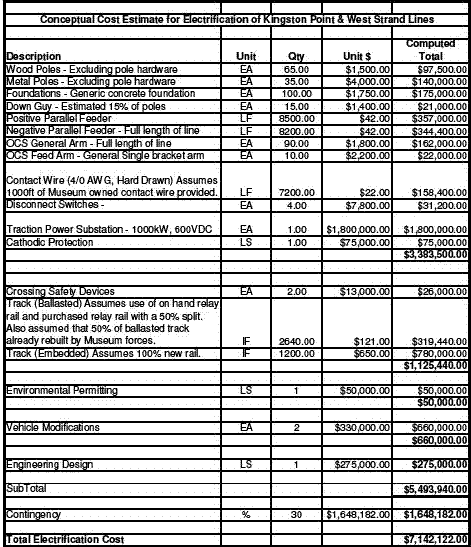
Electrification in simple terms involves running a wire 18' above our tracks that's powered by 600 volts.
This is important because it will allow the operation of our historic trolley and subway cars.
Until electrification happens, we are limited to running self-propelled equipment.
When the Museum moved to Kingston in 1983, electrification of the line was next year's project.
Unfortunately, the realities of our finances and location have held off the dream of electrification.
Electrification at TMNY has been a hard hurdle to cross for a number of reasons.
The same location that blesses TMNY with a varied route that includes waterfront scenery,
a historic district and a supply of tourists also bristles with underground utilities, most importantly gas pipelines.
Therefore TMNY couldn't just string some wire
without meeting the costly requirements of safeguarding the gas lines.
In 2006, the City of Kingston on the museum's behalf, commissioned a $50,000 engineering study to design and estimate the costs of electrification. HDR, Inc. was chosen for the study and the final report was delivered in 2008. HDR's estimate for the project, including track upgrades, overhead, 12-pulse rectifier substation, and completely restoring trolley B&QT 8361 (a double end Peter Witt) is $7.1M. So, TMNY has a little bit of money to raise! TMNY still has no endowment or other long-term means to sustain the current operation (including staff salary), so that will continue to be the focus of our own fundraising near-term.
Below is the entire cost sheet from the HDR report. This is based on prevailing wages and costs, so the actual price when shovel hits dirt may vary, hopefully downward with volunteers, in-kind services and donations factored in.

In 2009, U. S. Senator Charles Schumer announced an $800,000 federal earmark for track upgrades is in the Transportation, Housing and Urban Development appropriation. This is the largest grant that the museum has benefitted from so far in its history. None of the $800,000 goes to electrification per se, but about a mile of the existing track is updated to modern light rail standards as a prelude to eventual electrification.
HDR Inc. was once again chosen as the engineering contractor for this grant. In 2012 a bid was awarded to Riegel Rail Solutions, Inc. for the actual construction of the project. Work was completed in 2013.
The Board of Trustees will continue to seek grants to move electrification forward.
[ Ongoing Projects ]
This page was last updated by Omar Pagan on July 24, 2017.